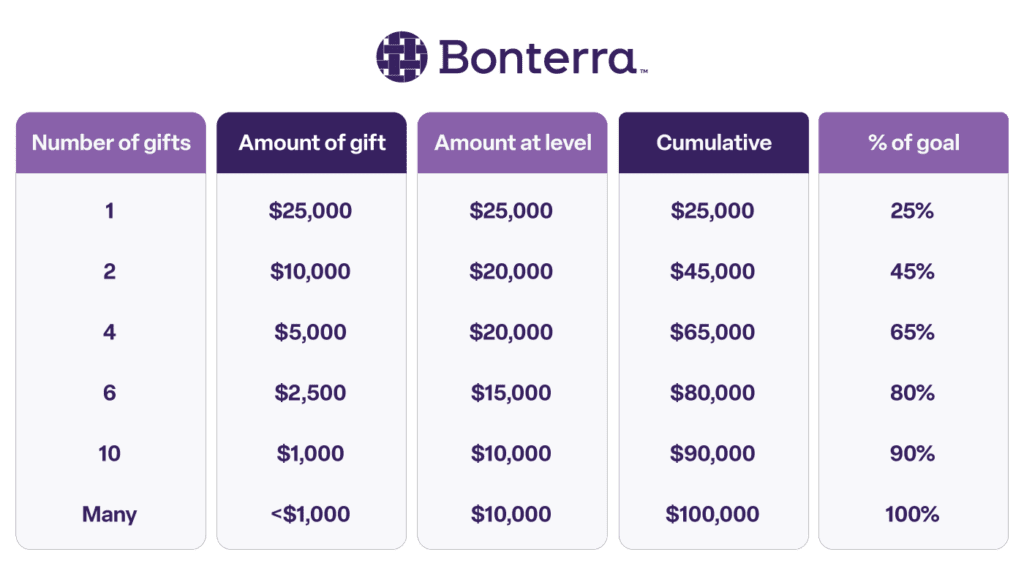What is a capital campaign? A nonprofit’s guide + examples [2025]

Most capital campaigns acquire multi-million dollar gifts over a long period for your nonprofit organization’s capacity-building projects. But, the right capital campaign examples can also help you achieve low-hanging fundraising goals.
The fundamentals of capital campaigns and a normal campaign are essentially the same: prepare fundraising tools and materials, research prospects, build relationships with donors, keep supporters updated about your campaign, and follow through on your promises to donors. Capital campaigns are simply on a bigger scale.
Let’s explore the essential capital campaign toolkit that you can apply to your next fundraiser.
What is a capital campaign?
A capital campaign plan is a type of fundraising strategy where nonprofits raise funds for monetarily large-scale projects or needs over a specific period. Examples of such major projects might include:
- Construction of a new building or major renovation: A nonprofit animal shelter might launch a capital campaign to build a larger facility to house more animals and offer expanded services.
- Property acquisition: A land trust might run a capital campaign to purchase a critical piece of wilderness to protect it from development.
- Endowment funds: A university might establish a capital campaign to grow its endowment, providing long-term financial stability and supporting scholarships
- Mission-driven initiatives: A social services organization might launch a capital campaign to expand its programs to a new geographic area, reaching more people.
- Equipment purchases: A hospital might conduct a capital campaign to purchase a new MRI machine, enabling them to provide more advanced diagnostic services to their patients.
Capital campaigns are different from other events in that they often involve a quiet phase where organizations request major gifts from a select group of donors, followed by a public phase to broaden community support.
Capital campaign timeline and phases
Capital campaigns are often complex and require careful planning and execution. There are typically three distinct phases of a capital campaign, each with its own set of activities and goals:
- Phase 1: Planning: Lays the groundwork for the entire campaign. It involves three mini phases, including:
- Pre-campaign planning: Exploring potential projects that align with the organization’s mission and strategic goals.
- Feasibility study: Interviewing potential donors to gauge their interest in the project.
- Campaign planning: Defining clear goals, creating a detailed budget, and outlining communication strategies.
- Phase 2: Quiet: Focuses on securing significant gifts from the organization’s inner circle before approaching the broader community. The goal is to build momentum for the public launch.
- Phase 3: Public: Engages the broader community. It involves actively seeking grants from foundations and corporations and engaging with the community through various outreach efforts.
- Phase 4: Closing: Focuses on finalizing fundraising efforts and securing any remaining pledges. This phase also involves acknowledging donors and documenting the campaign’s performance.
| Phase | Timeline | Purpose | Steps |
| 1. Planning | 4-6+ months | Create framework for campaign | Pre-planning Feasibility study Campaign planning |
| 2. Quiet | 6-8+ months | Secure major gifts from inner circle | Identify prospects Solicit gifts Build momentum for public launch |
| 3. Public | 12-36+ months | Engage broader community and solicit gifts | Launch public phase Implement outreach strategies Seek corporate sponsorships |
| 4. Closing | 2+ months | Finalize fundraising and celebrate success | Secure remaining pledges Acknowledge donors Review campaign performance |
How to run a capital campaign (with examples)
Here’s a step-by-step breakdown of a capital campaign toolkit for your nonprofit, from initial goal setting to sending personalized thank-you letters.

Step 1: Pick a project and set goals
Your capital campaign should aim to raise money for a specific project or operating expense. Inform supporters about what their gifts are supporting when you approach them with a donation request.
To start, make a short, annotated list describing what you want to raise money for. Be as clear and specific as you can. While setting your goals, remember to:
- Determine what you want to do with the money you are planning to raise.
- Set your goal high enough so that you’ll be able to accomplish what you want to get done with a cushion for unforeseen events. Set a goal that’s challenging but attainable.
For example, imagine your fundraising campaign aims to expand your after-school program. Your campaign could focus on providing scholarships for 50 children to participate in the program for a year. You might set a goal of $100,000, knowing that each scholarship costs $2,000.
Clearly stating that the funds will directly support scholarships makes the campaign more relatable and impactful for donors.
Step 2: Develop a Campaign Plan
Before preparing materials, create a detailed plan outlining how you will achieve your fundraising goal. This plan should encompass the following elements:
- Team: Identify and recruit key individuals to form a campaign committee. Define roles and responsibilities for each team member.
- Timeline: Establish a realistic timeline for each campaign phase, from initial planning to closing.
- Budget: Develop a detailed budget for all campaign activities, including marketing, events, and administrative costs.
- Marketing and outreach: Create a comprehensive marketing plan that includes strategies for reaching potential donors through various channels (e.g., social media, email, direct mail). This should include a clear communication strategy.
- Fundraising activities: Determine the specific fundraising activities you will undertake, such as grant applications, individual solicitations, corporate sponsorships, and special events.
- Event planning (if applicable): If you plan to hold fundraising or unveiling events, outline the logistics, including venue selection, catering, invitations, and program agenda.
- Key performance indicators (KPIs): Define measurable metrics to track progress and assess the effectiveness of your campaign strategies.
- Contingency planning: Consider potential challenges and develop contingency plans to address them.
This comprehensive plan will serve as your roadmap for the entire campaign, ensuring that all team members are aligned and working towards the same objectives.
Step 3: Prepare your campaign materials
Now, convert your bulleted list of goals into a simple, well-written document that explains the impact that supporters’ donations will have if they decide to give. For smaller capital campaigns, you should keep the material to just one or two pages. If there’s more detailed information that you think might be helpful, include that in a separate Q&A or fact sheet.
Keep these points in mind:
- Your campaign materials should highlight the benefits of your project rather than just describe the features. For example, let’s say you’ll use campaign funds to increase your food bank’s capacity. You should mention the exact number of meals you can donate with your fundraising goal and how many people they would accommodate.
- Use headings to make your materials easy to read. Make deciding to support your nonprofit as simple as possible. Keep your prospects engaged by making your case for support skimmable. Using the after-school program example, your headline might read “Give the Gift of Opportunity: Sponsor a Child’s After-School Education.”
- Ask people in your organization for their input. Nonprofit professionals and board members with an understanding of your nonprofit’s needs can provide valuable insight into how fundraising is going. Use their suggestions to improve your marketing materials and strategy.
Step 4: Develop your gift range chart
No matter the size of your campaign, the gift range chart will be your primary campaign planning tool. It shows the number of gifts at each giving level you will need to raise to reach your goal.
Start your chart at the top with one gift of at least 20% of your campaign goal. If your mini-capital campaign goal is $100,000, your top gift will be somewhere around $20,000. Each subsequent level will show more gifts at a lower giving level.
For example, your gift range chart might look something like this with a $100,000 goal:

The pattern of gifts loosely reflects the general pattern in nonprofit fundraising that 80% of your goal revenue will come from 20% of your donors. Stick to this plan as much as possible to achieve the best results.
Step 5: Make a list of your best prospects
Carefully review your gift range chart and note that you probably will only need about 10 gifts to raise more than half of your goal. Connecting with the right donors will save you time and allow you to pivot your approach as you fundraise.
In this step, list all of the people who might be able to make those top gifts. You likely won’t achieve your 10-gift goal right away, so to bring in those top 10 gifts, you should identify more than 10 people or sponsors. In fact, it’s best to make a list of around 30 prospects.
Within your nonprofit CRM, you can locate prospects who are likely to give to your capital campaign based on their engagement history with your organization. Segment any qualified prospects you find so that you’ll already have that contact list ready to go when it comes time to start reaching out.
Don’t forget to personalize your asks to cater to your donors’ preferences, such as mentioning the fund they’ve supported in the past or their average gift amount.
For example, to identify your 30 prospects, you might consider:
- Past major donors
- Board members and trustees
- Local businesses
- Alumni
- Foundations
- Community leaders
Step 6: Start contacting your best prospects
Now that your messages, contact list, and goals have been finalized, start contacting your prospective donors. Tell them you’d like to meet with them to ask for their support for a special project you’re working on.
Set a specific time for your conversation, confirm the meeting place and time, and email your campaign materials to them in advance.
To prepare for your discussion, always:
- Be prepared to answer the question, “How can I help?” Have a request in mind for that specific donor based on their interests, giving history, and relationship with your nonprofit.
- Have copies of your deliverables ready to distribute that explain the mini-campaign.
- Follow up directly after the meeting, thanking the prospect for their time and consideration, no matter how it went.
Remember that your prospects are likely very busy with professional and personal pursuits, so ensure you’re flexible around their availability. Offer virtual alternatives to in-person meetings if needed to accommodate their schedules and make your pitch.
If donors need more time to consider their, schedule a follow-up meeting to answer any more questions they might have, share additional materials, and continue building your relationship with them.
Step 7: Follow up with every donor
After a donor agrees to make a gift, you still have work to do. You’ve got to tie down all of the administrative details about the gift, thank the donor, and then communicate with them throughout the process.
During the follow-up process, ensure you:
- Remain responsive by replying to communications within 24 hours.
- Craft personalized thank-you letters and gifts for their support, depending on the gift size.
- Update your donors about new developments in the project.
Think of the follow-up process as the beginning of your next fundraiser rather than the end of your campaign. The smoother this process goes, the higher donor retention will be, so stay professional and vigilant.
Benefits of using a CRM for capital campaigns
Capital campaigns are notoriously complex, often stretching timelines and straining resources. But the right fundraising tool can simplify these challenges, allowing you to concentrate on the core mission: funding your vital project.
The benefits of using a CRM for your campaign needs include:
- Centralized data management: A CRM provides a central source for all campaign-related data for more accurate impact measurement. This eliminates the need for spreadsheets and manual tasks, ensuring everyone on the campaign team has access to the most up-to-date information.
- Improved donor cultivation: CRMs allow for detailed tracking of donor interactions, enabling personalized communication and targeted cultivation strategies. The right tool will allow you to segment donors based on giving history and other criteria, allowing you to personalize your appeals and build stronger relationships.
- Enhanced major gift management: CRMs are particularly valuable for managing major gift prospects. You can track interactions with major donors, manage proposals, and monitor the progress of major gifts, ensuring you stay on top of these crucial donations.
- Simplified reporting and analysis: CRMs provide robust reporting and analytics tools, allowing you to track campaign progress, identify trends, and measure the effectiveness of your strategies — from generating reports on fundraising performance to providing valuable insights for decision-making.
Grow the impact of your capital campaigns with Bonterra
Capital campaign fundraising is the most effective form of fundraising. Using the capital campaign examples outlined above, you can build productive donor relationships with your most important donors while improving your own fundraising skills, too.
Ready to take your capital campaign to the next level? Grow the impact of your capital campaigns with Bonterra.
FAQ
What is a capital campaign plan?
A capital campaign plan is a type of fundraising effort focused on raising money for a large-scale project or need, like a new building or endowment fund, over a specific period.
What is a capital campaign toolkit?
A capital campaign toolkit is a set of resources designed to help nonprofits plan and execute successful capital campaigns. It typically includes:
- A campaign plan (goals, timelines, strategies).
- Donor list (past donations, interests, giving potential).
- Campaign materials (brochures, social media).
- Fundraising letter templates.
- Tracking system (donations, pledges, donor info).
What are the three phases of a capital campaign?
The main three phases of a capital campaign for nonprofits are:
- Planning: Involves assessing the capacity to conduct a campaign, identifying potential donors, and developing a strategic plan.
- Silent: The campaign solicits major gifts from the organization’s leadership, board members, close supporters, and other “insiders.”
- Public: The organization reaches out to the wider community and potential donors to secure the remaining funds.
How long do capital campaigns last?
Capital campaigns typically last between 18 months and 3 years, though some can be shorter or longer depending on the size and complexity of the project.
Work with Bonterra



